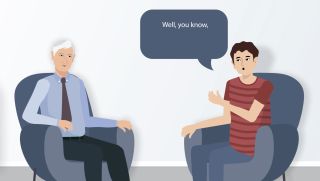Suicide
How Can We Reduce the Risk of People Repeating Suicide Attempts?
Effective therapy needs patients who are active participants.
Updated December 4, 2023 Reviewed by Abigail Fagan
Key points
- Most suicidal people can tell the story behind their suicidal crisis, but they need an attentive listener.
- Research shows the three-session therapy program ASSIP reduced the risk of suicide reattempts by 80%.
- The components of ASSIP are narrative interviewing, video-playback, and collaborative case formulation.

Why do people who attempt suicide need a specific type of therapy?
Individuals with a history of attempted suicide are a high-risk group for reattempts and suicide[2]. Between 16 and 20 percent reattempt suicide within one year. The risk remains elevated for decades, most probably lifelong. After an action of self-harm, people enter the medical system by presenting at an emergency department from where they can be taken into treatment. However, we know from several studies that up to 50% do not attend follow-up appointments or drop out of treatment within one week. One reason is that for many suicidal patients, the focus of the usual treatment is not relevant to them. The prevalent medical model understands suicidal behavior as a consequence of mental disorders, while suicidal people are trapped in an existentially threatening emotional turmoil and unbearable mental pain. A meaningful therapeutic dialogue needs two protagonists who share a common ground.
Therapeutic interventions that directly address suicidal thoughts and behavior are particularly effective[3]. Because of the widespread shortage of therapeutic resources, brief therapy programs for people who attempt suicide are particularly interesting. Considering the long-term increase of suicidal behavior after attempted suicide, the idea that therapy should "cure" people from suicidality is a fallacy. To my knowledge, there is no evidence that long-term treatments can abolish suicide risk in the long-term. Therefore, a more realistic goal is for patients to develop and internalize new safety strategies for coping with future suicidal crises.
We Need Patients With Active Therapy Engagement
We explain any action in our lives with a story. In hundreds of interviews with patients I interviewed after a suicide attempt, I learned that suicidal patients have an amazing narrative competence vis-à-vis an attentive listener. This meant that I had to abandon my role as the medical expert who knows all about suicide and suicidal behavior. I had to learn to sit back and give them enough room to tell me their story. The suicide story is not the life story, so in practice, the therapist and the patient usually come to a shared understanding of the suicidal development within 30 to 60 minutes. This will then allow the therapist to collaboratively assess suicide risk and develop personal safety measures. In a study, we showed that the narrative interviewing style is associated with better therapeutic alliance[4].
The Attempted Suicide Short Intervention Program ASSIP
ASSIP is a manualized therapy for patients who have attempted suicide. It is administered in three 60- to 90-minute sessions, ideally within three weeks. (For details see Michel and Gysin-Maillart [5].) All the ASSIP therapy components are aimed at maximizing the patients’ active participation and treatment engagement toward the goal of understanding one's own suicidality and being able to deal with future dangerous situations. Prior to the first session, patients receive written information explaining the structure of the therapy, the video recording, and the therapy goals.
In a recent qualitative study, patients treated with ASSIP said they had gained a clearer understanding of the dynamics and drivers of their suicidal behavior, allowing the formation of safety strategies, recovery goals and a more hopeful and/or confident outlook on the future[6].
First Session. The patients are invited to tell the story behind the suicide attempt. The aim of the narrative interview is to reach a patient-oriented understanding of the personal mechanism leading to suicidal behavior in a biographical context, and to elicit specific vulnerabilities and triggering events. The interview is video-recorded.

Second Session. Sequences of the video-recorded interview considered to be relevant for further elaboration are selected and viewed on the screen, with the patient and the therapist sitting side by side. The aim of the video playback is to put the patient into the role of the outside observer, and, together with the therapist, to reflect on triggers, personal vulnerability in a biographical context, and the transition from a mental pain experience to the suicide action. At the end of the session, patients receive a psychoeducative handout, which they are asked to read and comment in writing, and bring back to the next session. After the second session, the therapist prepares a draft case conceptualization, which includes a formulation of the individual vulnerability in the context of the patient’s biography and the specific triggering event(s).
Third Session. First, the patient’s feedback on the handout is discussed in a collaborative way. Then, the written case conceptualization is revised together with the patient and finalized. Long-term goals, individual warning signs, and safety strategies are developed. The case conceptualization and the safety strategies are printed and handed to the patient, with copies for the patient’s therapist and other relevant mental health professionals. The safety strategies are copy-pasted to a credit-card size ‘‘leporello’’ (a folded leaflet) and handed to the patient with the instruction to keep it in their wallet.
Continued Outreach Contact. Patients receive letters over a time span of two years, every three months in the first year, and every six months in the second year. The letters can be sent by surface mail, e-mail, or WhatsApp. The content is standardized, pointing out the need to keep in mind the safety plans developed in the therapy sessions. Letters are personally signed by the ASSIP therapist. Patients do not have to respond but are invited to give feedback about how things are going. If the therapist receives feedback from the patients via e-mail or letters no further re-connection is made until the subsequent letter, unless patients appear to be in a suicidal crisis, in which case the therapist contacts them. Any information received from the patient is usually referred to in the subsequent letter.
Conclusions
As long as clinicians see suicidal patients as passive objects and the clinician as the all-knowing expert we shall not move forward in reducing suicide. Clinical suicide prevention needs to integrate more psychotherapeutic concepts in the treatment of patients at risk of suicide.
My next post will be about personal needs, vulnerabilities, and suicide.
If you or someone you love is contemplating suicide, seek help immediately. For help 24/7 dial 988 for the National Suicide Prevention Lifeline, or reach out to the Crisis Text Line by texting TALK to 741741. To find a therapist near you, visit the Psychology Today Therapy Directory.
References
4. Michel, K., et al., Therapist sensitivity towards emotional life-career issues and the working alliance with suicide attempters. Archives of Suicide Research, 2004. 8(3): p. 203-13.
5. Michel, K. and A. Gysin-Maillart, ASSIP - Attempted Suicide Short Intervention Program. A manual for clinicians. 2015, Göttingen: Hogrefe Publishing.
1. Gaston, L., et al., Alliance, technique, and their interactions in predicting outcome of behavioural, cognitive, and brief dynamic therapy. Psychotherapy Research, 1998. 8: p. 190-209.
2 Owens, D., J. Horrocks, and A. House, Fatal and non-fatal repetition of self-harm Systematic review. The British Journal of Psychiatry, 2002. 181(3): p. 193-199
3. Meerwijk, E.L., et al., Direct versus indirect psychosocial and behavioural interventions to prevent suicide and suicide attempts: a systematic review and meta-analysis. Lancet Psychiatry, 2016. 3(6): p. 544-54.
6. Gaily-Luoma, S., et al., Client-reported impact of the Attempted Suicide Short Intervention Program. Psychother Res, 2023: p. 1-14.




